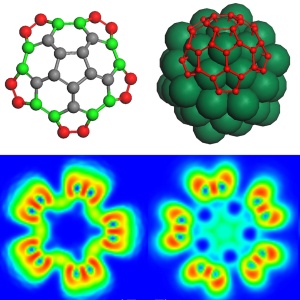|
from NatureAsia Website
before (left) and
after (right) binding to the metal cluster (green). Single-walled carbon nanotubes (SWCNTs) are poised to revolutionize the engineering of high-performance electronic devices.
These rolled-up carbon sheets behave like metals or semiconductors according to their orientation and degree of twisting, or chirality. Unfortunately, the mechanisms that govern the formation of these cylindrical structures remain unclear, making their geometry difficult to control during synthesis.
Now, using quantum simulations, a team
led by Yuan Chen from Nanyang Technological University
in Singapore has elucidated the role of charge transfer in chiral
nanotube growth.1
However, these studies have been unable to provide a convincing explanation of the chirality selection observed experimentally.
His team carried out calculations for various nanotube structures growing on a nickel cluster.
Unfortunately, these simulations revealed very little in terms of energy differences between the investigated compounds, suggesting that the cluster did not drive chirality - a major discrepancy from experimental results.
Conversely, the researchers noticed
that, in agreement with transmission electron microscopy
observations, the geometries of the cluster and growing structures
deformed upon binding to one another, indicative of a highly
reactive interface between the cluster surface and the extremities
of the growing nanotube.
Moreover, this charge redistribution, which occurs exclusively at the cluster-carbon structure boundary, displays specific patterns depending on the carbon ‘cap’ chirality.
Reference
Author affiliation
|

